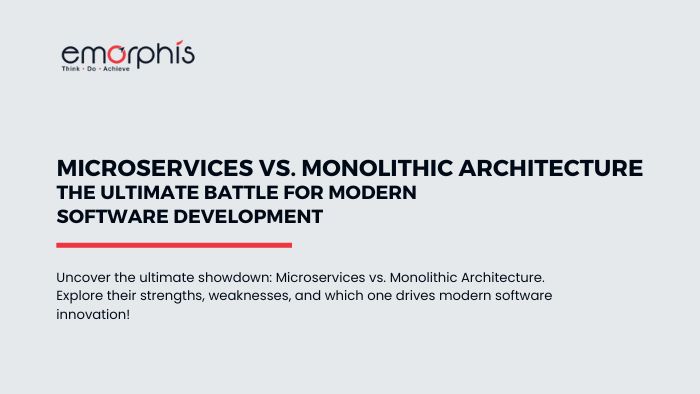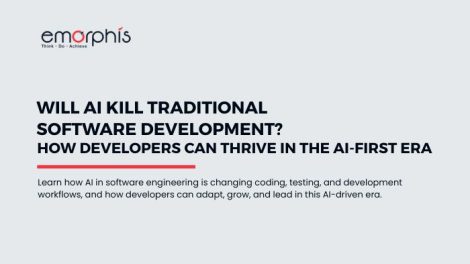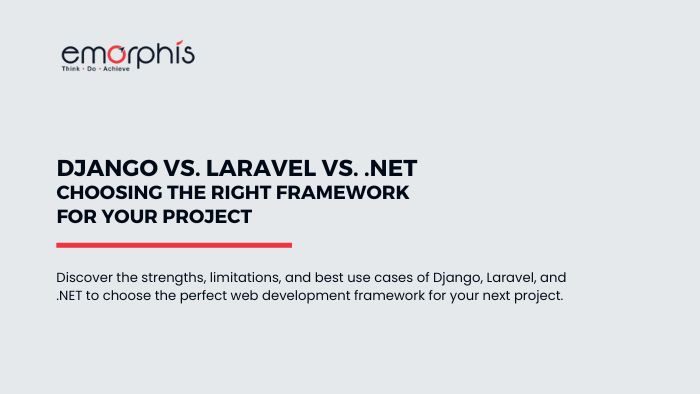In the ever-evolving software development landscape, architects and developers often find themselves grappling with one crucial decision, microservices vs. monolithic architecture. Both these architectural patterns have their strengths and challenges, and choosing the right one depends on the project’s specific requirements.

Let us now explore the intricacies of microservices vs. monolithic architecture.
What is Monolithic Architecture?
Monolithic architecture is the traditional approach to software development, where all components of an application are tightly coupled and packaged into a single unit. It includes the user interface, business logic, and data access layers, all bundled together.
Key Characteristics of Monolithic Architecture
- Unified Codebase: The entire application is built as one cohesive unit.
- Tightly Coupled Components: All modules are interdependent, making changes to one part impact the whole system.
- Centralized Deployment: Monolithic applications are deployed as a single entity, simplifying deployment but complicating scaling.
Advantages of Monolithic Architecture
- Simplicity: Easy to develop, test, and deploy in the initial stages.
- Performance: Direct communication between components leads to faster execution.
- Ease of Debugging: Since everything is in one place, identifying and fixing issues is straightforward.
Challenges of Monolithic Architecture
- Scalability: Scaling individual components is impossible; the entire application must be scaled.
- Complexity in Maintenance: As the application grows, maintaining and updating it becomes cumbersome.
- Deployment Bottlenecks: A small change requires redeployment of the entire application, increasing downtime.
What is Microservices Architecture?
Microservices architecture takes a different approach by breaking down an application into smaller, independent services, each responsible for a specific function. These services communicate with each other via APIs.
Key Characteristics of Microservices Architecture
- Decentralized Architecture: Services are developed and deployed independently.
- Independent Scalability: Each service can be scaled based on demand.
- Polyglot Programming: Developers can use different languages and technologies for other services.
Advantages of Microservices Architecture
- Flexibility: Teams can develop, deploy, and scale services independently.
- Resilience: Failure in one service does not necessarily bring down the entire system.
- Scalability: Services can be scaled independently, optimizing resource usage.
Challenges of Microservices Architecture
- Complexity: Managing a distributed system requires robust tools and expertise.
- Communication Overhead: Services must communicate over the network, which can introduce latency.
- Operational Overhead: Monitoring, logging, and deploying multiple services require additional effort.
Key Differences: Microservices vs. Monolithic Architecture
| Feature | Monolithic Architecture | Microservices Architecture |
| Structure | Single, unified codebase | Multiple, independent services |
| Scalability | Scale entire application | Scale individual services |
| Development Speed | Slower as the application grows | Faster due to smaller, independent teams |
| Technology Flexibility | Limited to a single stack | Freedom to use diverse technologies |
| Fault Tolerance | Entire system impacted by failures | Isolated failures in individual services |
| Deployment | One large deployment unit | Independent service deployments |
| Complexity | Lower operational complexity | High operational complexity |
| Cost | Lower initial investment | Higher upfront infrastructure costs |
Explore our Cloud-native app development services.
When to Choose Monolithic Architecture?
Monolithic architecture, the traditional choice, thrives under specific circumstances where simplicity, speed, and straightforward execution are paramount. Here’s when monolithic architecture shines in the microservices vs. monolithic architecture comparison:
1. The Application is Simple and Has a Small User Base
- When the application serves a niche audience with limited features and straightforward workflows, monolithic architecture proves optimal.
- For startups or Minimum Viable Products (MVPs), simplicity often outweighs scalability concerns, tilting the balance in favor of monolithic solutions in the microservices vs. monolithic architecture decision.
2. Speed to Market is a Priority, and the Team is Small
- With a single codebase, smaller teams can collaborate effectively, delivering features quickly without the operational overhead associated with microservices.
- The tightly coupled nature of monolithic systems simplifies development, tipping the scale in the microservices vs. monolithic architecture analysis for projects prioritizing speed.
3. Long-Term Scalability and Flexibility Are Not Critical
- For internal tools or applications with predictable workloads, monolithic architecture minimizes overhead.
- In scenarios where growth is unlikely, monolithic systems stand out in the microservices vs. monolithic architecture comparison for their simplicity.
4. Development Involves Straightforward Use Cases with Minimal Expansion
- When business logic and technical requirements are stable, monolithic architecture reduces the effort required for implementation.
- This stability gives monolithic systems an edge in the microservices vs. monolithic architecture debate for projects with clear and unchanging requirements.
When to Choose Microservices Architecture?
Microservices architecture, a modern and modular approach, thrives in scenarios requiring flexibility and scalability. Here’s why it stands out in the microservices vs. monolithic architecture debate:
1. The Application Needs to Scale Rapidly to Handle High User Demand
- By allowing individual services to scale independently, microservices optimize resource usage.
- For example, an e-commerce platform can scale its search and payment services independently, showcasing its advantage in the microservices vs. monolithic architecture discussion.
2. Flexibility in Technology Choices is Required
- Teams can use different programming languages and frameworks for specific services, aligning with modern development needs.
- This adaptability makes microservices a strong contender in the microservices vs. monolithic architecture battle when technical diversity is essential.
3. Teams Are Large and Distributed, Working on Multiple Features
- Decentralized development in microservices supports agile methodologies, enabling faster innovation and feature delivery.
- This independence highlights its superiority in the microservices vs. monolithic architecture decision for large-scale, dynamic teams.
4. Fault Tolerance and High Availability Are Critical
- Microservices isolate failures, ensuring the overall system remains operational.
- For instance, if a recommendation service fails, core functionalities like payment processing remain unaffected, strengthening its position in the microservices vs. monolithic architecture debate.
5. Continuous Deployment and Innovation Are Keys
- Independent service deployment in microservices accelerates updates and reduces downtime, making it a winner in the microservices vs. monolithic architecture comparison for rapidly evolving applications.

Hybrid Approach: Bridging Microservices vs. Monolithic Architecture
Sometimes, the best solution in the microservices vs. monolithic architecture debate is a hybrid model, combining monolithic systems’ simplicity with microservices’ scalability.
1. Start with Monolithic Architecture
- For small projects, monolithic architecture facilitates quick development and validation.
- This approach minimizes costs and complexity while providing a solid foundation in the microservices vs. monolithic architecture decision process.
2. Transition to Microservices as the Application Grows
- As the application scales or requires additional features, specific components can be modularized into microservices.
- This phased approach balances the needs of microservices vs. monolithic architecture, ensuring adaptability.
3. Balance Complexity and Agility
- By adopting microservices selectively, teams avoid over-engineering, creating a strategic path for growth.
- This flexibility resolves the microservices vs. monolithic architecture dilemma, providing a tailored solution for evolving needs.
The choice between microservices vs. monolithic architecture is not one-size-fits-all. Monolithic systems excel in simplicity and speed for small-scale applications, while microservices shine in scalability and flexibility for complex, dynamic projects. By understanding their strengths and challenges, teams can make informed decisions tailored to their application’s needs, leveraging the best of both worlds where necessary.
Tips for Migrating from Monolith to Microservices Architecture
Transitioning from a monolithic architecture to a microservices architecture is a strategic move that offers improved scalability, flexibility, and fault isolation. However, it can be complex and requires careful planning. Below are actionable tips to guide you through the migration process:
1. Understand the Current System
- Audit the Monolith: Identify tightly coupled components, bottlenecks, and critical dependencies.
- Map Dependencies: Document the interactions between various modules, databases, and external systems.
- Define Boundaries: Understand which components can logically be separated into independent services.
2. Set Clear Goals
- Define Objectives: Clarify why you are migrating (e.g., scalability, faster deployment, fault isolation).
- Prioritize Services: Determine which parts of the monolith will deliver the most value when migrated first.
3. Start Small with a Proof of Concept (PoC)
- Choose a Non-Critical Component: Start with a service that has low risk and less dependency on other modules.
- Build and Deploy: Test the service independently to refine the migration approach.
4. Use Domain-Driven Design (DDD)
- Identify Bounded Contexts: Break the monolith into logical domains that can function as independent microservices.
- Align with Business Needs: Ensure each service aligns with a specific business capability.
5. Implement API Gateways and Communication Layers
- API Gateway: Use an API gateway to manage traffic between services and handle authentication, rate limiting, and load balancing.
- Standardized Communication: Decide between synchronous (e.g., REST, gRPC) and asynchronous (e.g., message queues) communication based on use cases.
6. Decouple Data
- Database Per Service: Each microservice should have its own database to ensure independence and scalability.
- Data Synchronization: Use event-driven architecture or data replication to maintain consistency across services.
7. Embrace DevOps Practices
- Continuous Integration/Continuous Deployment (CI/CD): Automate testing, building, and deployment pipelines to manage microservices efficiently.
- Containerization: Use tools like Docker to package services and Kubernetes for orchestration.
8. Monitor and Test Extensively
- Monitoring Tools: Implement centralized logging and monitoring tools like ELK Stack, Prometheus, or Grafana to gain visibility.
- Testing Frameworks: Use contract testing for APIs and end-to-end testing to validate interactions between services.
9. Refactor Gradually
- Strangler Fig Pattern: Replace parts of the monolith incrementally by building new microservices around existing functionality.
- Decompose Module by Module: Avoid breaking the monolith all at once to reduce risk and disruption.
10. Train Your Team
- Upskill Developers: Provide training on microservices best practices, distributed systems, and DevOps tools.
- Cross-functional collaboration: Encourage communication between teams working on different services.
11. Prepare for Challenges
- Handle Latency: Design services to tolerate latency from network communication between microservices.
- Manage Failures: Use patterns like Circuit Breaker and Retry mechanisms to handle service outages gracefully.
- Avoid Over-Engineering: Resist the temptation to create too many microservices, leading to unnecessary complexity.
12. Review and Iterate
- Monitor KPIs: Track performance, scalability, and reliability metrics to measure success.
- Gather Feedback: Collect feedback from development teams and users to refine the migration process.
Find the top 15 software product development trends you should look for.

Key Tools and Technologies for Migration
- Containerization: Docker, Kubernetes
- Message Queues: RabbitMQ, Apache Kafka
- API Management: Kong, Amazon API Gateway
- Monitoring: ELK Stack, Prometheus, Jaeger
Migrating from monolith to microservices is not just a technical decision but a business strategy. By starting small, planning meticulously, and leveraging modern tools, you can achieve a smooth transition. While challenges like increased operational complexity and data consistency need careful handling, the benefits—scalability, agility, and innovation—are well worth the effort.
Partner with Emorphis Technologies for Microservices Success
Transitioning to a microservices architecture or optimizing your existing design requires deep expertise and precision. At Emorphis Technologies, our Microservices Design and Microservices Development experts bring years of experience in building scalable, resilient, and future-ready applications tailored to your business needs.

Whether you’re modernizing a monolithic application, designing from scratch, or seeking to improve your current microservices ecosystem, we offer end-to-end solutions that align with your goals. Partner with us to leverage cutting-edge tools, proven methodologies, and a customer-first approach.
Let’s design and build your next-generation application together. Connect with Emorphis Technologies today!







